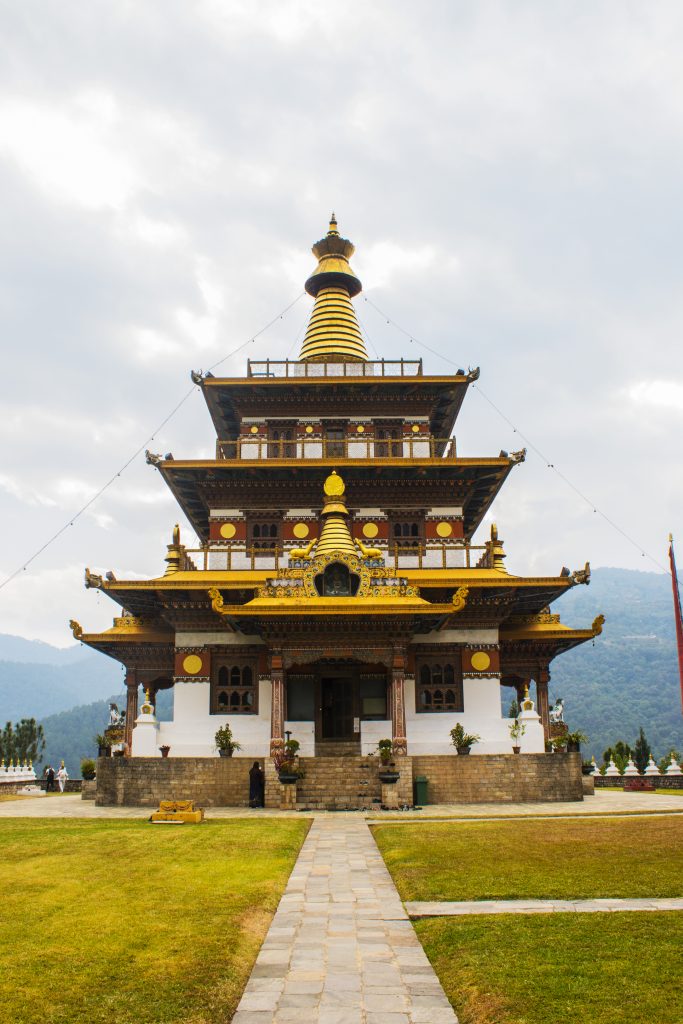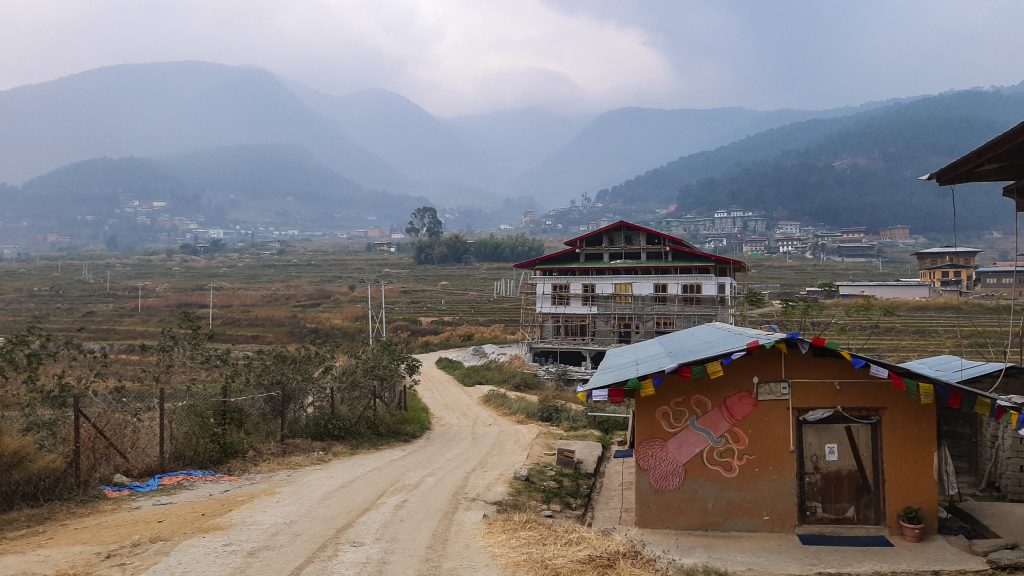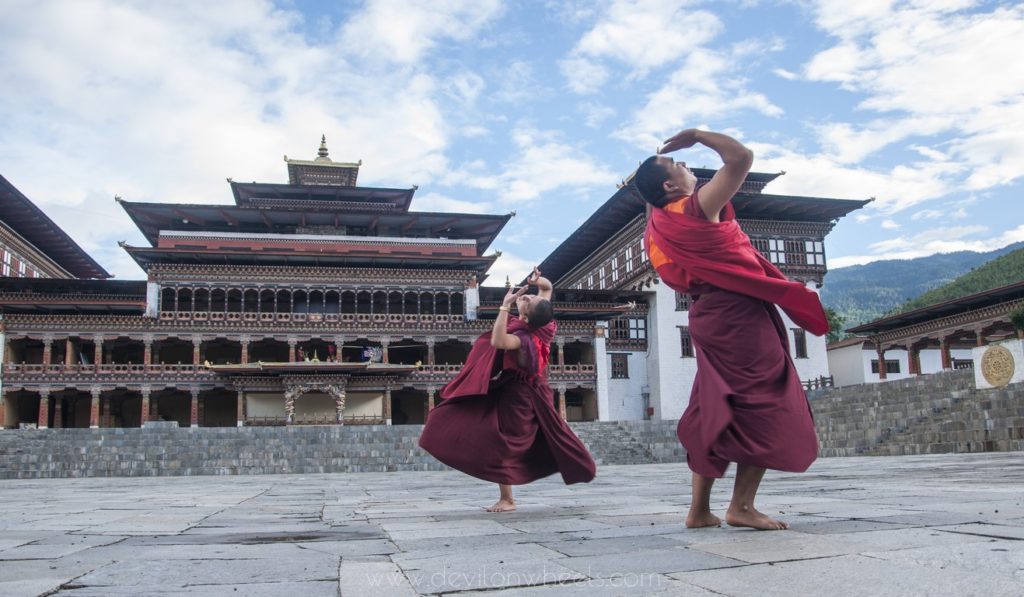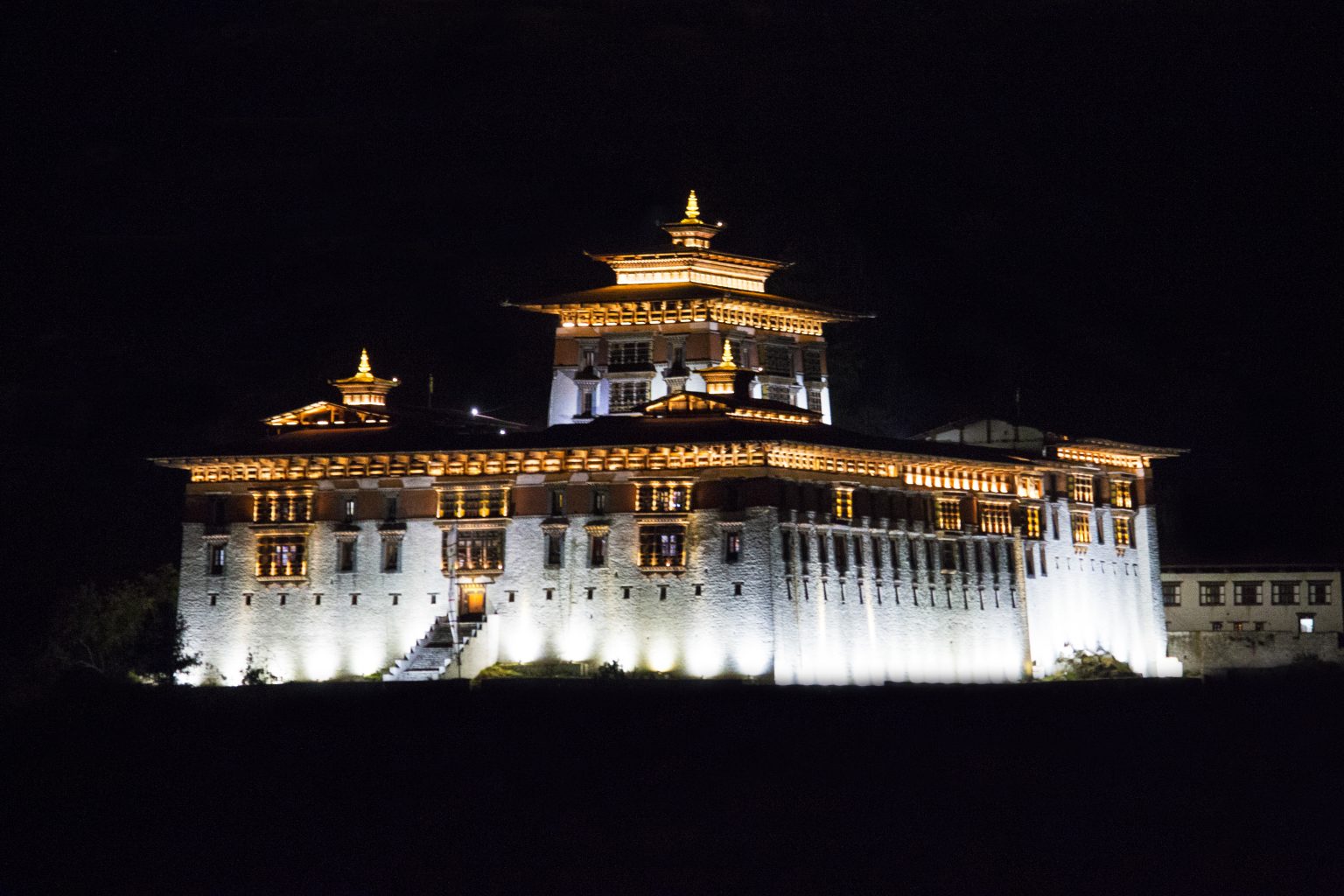Bhutan, a nation that’s famous for valuing happiness above all else. There’s something magical about the Land of the Thunder Dragon, which embraces you completely into its simple yet stunning ways. The insanely beautiful Himalayan views, the wholesome climate, the welcoming culture all add up to the experience that is Bhutan.

While this might seem clichéd, Bhutan is gorgeous in the purest of ways. It is off-beat enough to make you feel like you’re in a different part of the world in a different era altogether. Yet, the key steps that the country has taken makes it so much more modern than most places in the world.
Let's quickly dive into the details:
About Bhutan
Because of the violent and large thunderstorms that whip down through the valleys from the Himalayas, Bhutan is known as the Land of Thunder Dragon. People believe that the sparkling light of thunderbolts as the red fire of a Dragon. The Druk is the Thunder Dragon of Bhutanese mythology and a Bhutanese national symbol.
Geography
Bhutan is a landlocked country in Asia sandwiched in between India and Tibet. Gangkhar Puensum, the highest peak in the country, towering at 24,840 ft. Above sea levels! Despite the transformation and expansion of transport in Bhutan, including a National Highway System, travel from one region to the next remains difficult.

Mountains
There are many other prominent Himalayan peaks in Bhutan with some of the most rugged mountain terrains residing here! The mountains of Bhutan define its three main geographic zones – the Great Himalaya, the Lower Himalayan Range (or Inner Himalaya), and the Sub-Himalayan Range.
The snow-capped Great Himalaya in the north ranges from about 18,000 ft. to peaks of over 24,600 feet above sea level, extending along the Bhutan-China border. The northern region consists of an arc of glaciated mountain peaks with a northern climate at the highest elevations.
Pro Travel Tip: Do not forget to check this complete travel guide for traveling to Eastern Bhutan.
Valleys
Bhutan’s valleys are carved into the Himalaya by its rivers, fed by glacial melt and monsoon rains. Much of the Bhutanese population is concentrated in valleys and lowlands, separated by the rugged southward spurs of the Inner Himalaya.
The Flag of Bhutan
Even the flag of the country has many stories to tell. The Yellow is symbolic of the power of the King. The Orange is associated with the Bka’-Brgyud-pa (Kagyupa) and Rnying-ma-pa (Nyingmapa) Buddhist sects to signify the religious commitment of the nation.
The Dragon is Druk, the Thunder Dragon of Bhutanese mythology. The White is associated with purity of thoughts and inner deeds. In its claws, the dragon grasps four jewels symbolizing Wealth & Security.

History of Bhutan
The earlier history of Bhutan is immersed in mythology and remains quite ambiguous. In fact, not much is known about the region prior to the introduction of Tibetan Buddhism in the 9th Century.
The country’s political and religious history remains highly intertwined and the country remains one of the only few places never been conquered, colonized or occupied and governed by a foreign country.
The Kings of Bhutan have stepped up their game and given way to a better life for their tribe – bringing in new eras of developments through absolute control. When the country decided to become a democracy in 2005, they circulated the draft of the constitution to every citizen.
Per the Constitution, the monarchy is given a leadership role in setting the direction for the government as long as the King shall demonstrate his commitment and ability to safeguard the interests of the kingdom and its people.
Pro Travel Tip: Do not forget to check this complete travel guide for traveling to Tiger’s Nest Monastery in Bhutan.
Why Visit Bhutan?
With one foot resting firmly in the past and the other balancing modernity to the fullest, Bhutan is a case study waiting to be understood. Bhutan is one country which embraces the modern era but is sharply aware of the downsides of rapid modernization.
Thus, it has decided to move cautiously to maintain its soul, its integrity – the one thing that makes it stand out. Sustainable socio-economic development, safeguarding, and elevation of culture and tradition, and preservation of its natural environment are at the forefront of government policy.
The government’s ‘high value-low volume’ tourism policy is an amazing example of its efforts to keep foreign influences at bay while nurturing Bhutanese values at home. So much so, that the minimum daily expenditure set up for foreigners visiting the country, a substantial portion is directly earmarked for the welfare of its population.
Combine doing good for an entire country with the beautiful monasteries, the stunning festivals, the forts, the happiness as well as the sheer blissful nature – and you’re truly in for a treat! Add to that the amazing cuisine and the unique arts of the region, and you have a recipe for an amazing, unforgettable vacation.

Weather in Bhutan
The weather in Bhutan is similar to other Himalayan cities and towns. Rhododendron blooms of the spring months follow excruciatingly cold winter months. The heat and humidity start increasing from May onwards, and with June comes the onset of the monsoon – which is never a fun time in the hills – brings with it a lot of landslides.
Best time to visit Bhutan
While March to April is among the most popular time to visit Bhutan, for me, October –December is the best time to be visiting Bhutan, with clear air and sunny skies. January-March is the coldest period and might not allow you a lot of explorations and excursions. You can view the rare black-necked cranes in the Phobjikha Valley between late October and mid-February. So, that is an ideal time to head to the Happiness Nation.
How to reach Bhutan from India
You have many options available to reach Bhutan from India. You can make a road trip, or you can fly directly to Bhutan and travel by road inside it. Let us look at each option in detail.
By Air
Flying from India to Bhutan is easy and takes a total flying time of 2.5 hours. Paro International Airport is the only international airport to enter into Bhutan. Also, access is limited to two Bhutanese national airline carriers.
The Druk Airlines & Bhutan Airlines operates regular flights to and from Paro to Delhi, Kolkata, Bagdogra, Bodhgaya & Guwahati in India as well as from Bangkok (Thailand), Dhaka (Bangladesh), Kathmandu (Nepal) & Singapore.
Do note, Indian travellers can be offered special fares in Drukair, if the airline is contacted through email.

By Rail
Railways are the cheapest way to reach Bhutan from India. Jaigaon is a small Indian village on the Indo-Bhutan Border. Hasimara, the nearest railway station to Jaigaon, is situated at a distance of 17 km.
Frequent trains are available from Kolkata (690 km), Delhi (1663 km), Ranchi (749 km), and Kanpur (1197 km). While it might be a time-consuming option – it is a great way to save money!
By Road
Roadways are the most common way of entering Bhutan from India. Jaigaon is the closest Indian town to Bhutan. The distance of Jaigaon is 4.3 km from the border town of Bhutan, Phuentsholing.
While private cabs are available between the two places at prepaid rates, you can easily haggle with the cabs to bring the rates down further. Folks using the railways or domestic flight options can fetch cabs to take you to the nearby town of Phuentsholing.
Anyone can walk into the border town of Phuntsholing without any documents, no questions asked. However, to visit any other town in Bhutan, you will require the entry permit which you need to get from the Immigration Office in Phuntsholing.
Visa & Permit Requirements in Bhutan
Bhutan has a US$ 200-250 (depending on the season) per tourist per day minimal expenses defined. While, currently, citizens of India, Bangladesh or Maldives are exempted from this daily tariff. However, for all others this isn’t simply a visa, but rather covers the cost of just about everything during your stay.
As per Bhutan’s tourism website, it covers:
- A minimum of 3-star accommodation (4 & 5 stars may require an additional premium).
- All meals
- A licensed Bhutanese tour guide for the extent of your stay
- All internal transport
- Camping equipment and haulage for trekking tours
- All internal taxes and charges
- A sustainable tourism royalty of $65 (this royalty goes towards free education, free healthcare, poverty alleviation, along with the building of infrastructure)

Do Indians need a visa?
As of January 2020, if you’re a Citizen of India, Bangladesh, or the Maldives, you can visit Bhutan without paying this daily tariff. Also, citizens of these countries are not obligated to hire a guide for their stay, even though it is compulsory for other nationalities. So, it provides you with a lot of freedom to explore the country.
As an added advantage, Indian tourists traveling to Bhutan do NOT need a visa. However, we need an Entry Permit to visit the country. In terms of accepted identification, for Indian Nationals, Original Passport or Original Voters ID Card is acceptable to the Bhutanese Government.
However, you should note that to restrict the number of growing regional tourists, the Government of Bhutan is soon planning on charging a daily tariff or visa fee. They have not yet finalized the new law and concerning charges so far, but we can expect it to happen sometime in early 2020.
Also, if you don’t have or have lost your passport or voters id card then you can visit the Indian Embassy there and show proof of identity and get a citizenship slip from the ambassador and present it at the immigration.
Permits required to visit Bhutan
When you’re visiting Bhutan, keep in mind that you’d require two permits – Entry Permit & Route Permit. The max duration for Entry + Route permit is valid for 15 days. Do note that these permits are available free of cost.
Pro Travel Tip: You can check this detailed guide on how to get all the necessary permits of Bhutan [2020 updates included].
Entry Permit for Bhutan (Documents and Process
You’ll be able to obtain the same at Paro Airport or from the Immigration Office of Phuntsholing. These are the only two ways to enter Bhutan. The Entry permit is valid to visit places such as Thimphu (the capital) and Paro only and has a validity of 7 to 10 days.
Important Note: The Immigration office is closed on Saturday, Sunday and Public Holidays. The permits are checked at every check post in Bhutan. Working hours are strictly from 9 am to 5 pm and lunch break is from 1 to 2 pm.

Documents required for Bhutan Entry Permit for Indians
Fill in the entry form given at the Immigration Office and attach it in the below sequence
- Correctly filled Entry Permit Form
- Passport size photo to be fixed to the Entry Permit Form x1 (keep more just in case)
- Short Itinerary Print Out x1
- Photocopy of Hotel Booking for first night x1
- Xerox of Passport/Voters Id Card x1 of all travelers
- Undertaking (for solo travelers only)
Pro Travel Tip: Do not forget to check this complete travel guide for traveling to Central Bhutan.
Process for Entry Permit if coming via Phuntsholing
- Collect a form from the Immigration Office.
- Attached all the documents in the above sequence
- Stand in the queue to submit the form
- Then wait in a separate queue where you will be called for the biometric and verification
- If you have submitted your Voters Id, then after biometric, you have to go to a separate window for verification
This whole procedure can take anywhere between 3 to 8 hours depending on the number of people in the Queue.
Pro Tip: Avoid travelling on a Monday or on days where the Immigration office has been shut for 2 or more days at the stretch. Always better to be first in the Que, even if it means standing 2 hours before the office opens.
Important Note: If you’re on a package tour to Bhutan and your tour includes a Bhutanese Guide then the entry permit procedure can be done online by your travel agent. Only clear scan copy of your passport has to be submitted to your agent.
Process for Entry Permit if coming via Air to Paro
If traveling via air to Paro, you just simply fill the Entry Form at the airport and move out. The process is smooth and quick.

Route Permit in Bhutan
Once you’ve arrived in Thimphu, you will need to attain a route permit. This permit will allow you to visit all other places you might fancy, such as – Chele La, Ha Valley, Douch La, Punakha, Gangtey, Phobjikha Valley, Trongsa, Bumthang Region, etc.
Process for Route Permit
Stand in a queue to submit the required documents, the same as the entry permits, then come back after an hour to collect it. This whole process can take up to 2 hours.
Extension Permit in Bhutan (Process & Document)
Of course, if you’re planning on staying longer than 7-10 days (and you should!), then you’ll need an extension for your permit. For this, you’ll need to visit the Immigration Office at Thimphu and avail the extension.
Documents required for Bhutan Route Permit for Indians (to be filled at the Immigration Office at Thimphu)
- Correctly filled Route Permit Form
- Photocopy of Short Itinerary x1
- Photocopy of the entry stamp x1
- Original & Photocopy of Passport/Voters Id Card x1
Extension Permit Form
In addition to the above documents for the Route Permit, you have to attach the extension form with a photocopy of the taxi driver’s license x1 or photocopy of the bus ticket if traveling by bus. Max duration is 15 days from the day of arrival.
Process for Extension Form
You need to first submit the extension form with the correct documents to a separate office at the Immigration Office in Thimphu and come back after an hour or so to collect it.
Once the extension is granted, you go stand in the queue to submit your documents for the route permit.

Most Common Itineraries for Bhutan
I will be creating separate detailed itineraries for you in the near future. Of course, you can always check this perfect itinerary for a Bhutan Road trip.
However, do note that some of the most common itineraries for visiting Bhutan are as below:
Most common Itinerary 7 Nights | 8 Days via Air (Relaxed)
Day 1: Arrive at Paro Airport & drive to Thimphu. Rest.
Day 2: Thimphu Local Sightseeing
Day 3: Thimphu to Punakha via Dochu La (3100m/10,171ft.). Explore.
Day 4: Punakha Excursion to Gangtey
Day 5: Punakha to Paro via Dochu La. (3100m/10,171ft.).
Day 6: Paro (Hike to Tiger’s Nest/Taktsang Monastery)
Day 7: Paro Local Sightseeing & Excursion to Chele La (3988m/13,083ft.)
Day 8: Paro Airport Drop
Most common Itinerary 7 Nights | 8 Days via Land (Fast-Paced)
Day 1: Arrive early at Bagdogra Airport/New Jalpaiguri Railway Station in Siliguri and drive to Phuntsholing
Day 2: Phuntsholing Permit Work and drive to Thimphu
Day 3: Thimphu Local Sightseeing. To check for route permits.
Day 4: Thimphu to Punakha via Dochu La (3100m/10,171ft.)
Day 5: Punakha to Paro via Dochu La (3100m/10,171ft.). Local Sightseeing
Day 6: Paro (Hike to Tiger’s Nest/Taktsang Monastery) &/or Excursion to Chele La (3988m/13,083ft.)
Day 7: Paro to Bagdogra via Phuntsholing
Day 8: Depart Bagdogra
Pro Travel Tip: Do not forget to check this complete travel guide for traveling to Western Bhutan.
Two Weeks Bhutan Itinerary (14N/15D)
Day 1: Arrive early at Bagdogra Airport/New Jalpaiguri Railway Station in Siliguri and drive to Phuntsholing
Day 2: Phuntsholing Permit Work & Sightseeing
Day 3: Phuntsholing to Thimphu
Day 4: Thimphu Permit Work & Local Sightseeing
Day 5: Thimphu Local Sightseeing
Day 6: Thimphu to Punakha via Dochu La (3100m/10,171ft.)
Day 7: Punakha Sightseeing
Day 8: Punakha to Gangtey/Phobjikha Valley
Day 9: Phobjikha Valley to Trongsa via Pele La (3423m/11,230ft.)
Day 10: Trongsa to Bumthang
Day 11: Fly from Bumthang to Paro & drive to Ha Valley via Chele La (3988m/13,083ft.)
Day 12: Ha Valley to Paro via Chele La (3988m/13,083ft.)
Day 13: Paro Local Sightseeing
Day 14: Paro (Hike to Tiger’s Nest/Taktsang Monastery)
Day 15: Depart Paro by Air or Drive to Phuntsholing/Bagdogra

FAQs about a trip to Bhutan
<strong>What’s the time difference in Bhutan when compared to India?</strong>
Bhutan is 30 minutes ahead of India, i.e. GMT+6
<strong>What is the currency in Bhutan?</strong>
The Ngultrum (pronounced as Gultrum) is currently pegged to the Indian rupee at parity. (1 Ngultrum = 1 INR).
<strong>Can I use Indian Currency in Bhutan?</strong>
Indian Currency is widely accepted in Bhutan. However, some issues might arise at remote locations in Eastern Bhutan, where only a small fraction of the tourist visit. The new currency notes of INR 500 and INR 2000 are accepted as well but don’t expect small vendors to provide a change in INR. The balance change given to you will be in Ngultrum.
<strong>How expensive is a visa for Bhutan usually?</strong>
Bhutan isn’t cheap, and at a minimum, you’re going to pay $200-250 per person per day (daily tariff/tourist tax) depending on the season. At present, citizens of India, Bangladesh or Maldives are exempted from this daily tariff.
<strong>Is Bhutan safe and friendly towards Solo Travelers?</strong>
Bhutan isn’t particularly solo traveler-friendly. You can find cheap lodges everywhere, but you will not meet other travelers to share taxi costs for local sightseeing, thus, making the trip very expensive.Buses and shared taxies are available for moving from town to town, but once you have arrived at your destination, you will have to hire a taxi for sightseeing. The cost for a hatchback car full day will set you back by INR 2500-3000. Not just that, it’s also difficult to get permits as a solo traveler wanting to explore Bhutan. The Government of Bhutan wants people to travel in groups.

Conclusion
If you’re anything like me and love the Himalayas with all your might – Bhutan is worthy of exploration. There is a lot to see and experience in the tiny nation, which will provide you with a lot of perspective in life.
Have a travel question?? You can subscribe to my YouTube channel and leave a comment to ask your travel questions on traveling to the Himalayas.
You’ll fall in love with the way of life in Bhutan and wonder why most nations can’t think similarly. The beauty of the region will leave you shell-shocked, and the places you see will forever become a part of you.
Buckle up, because there are a lot of detailed posts coming up on Bhutan and all you’ll need to do to enjoy the country!






